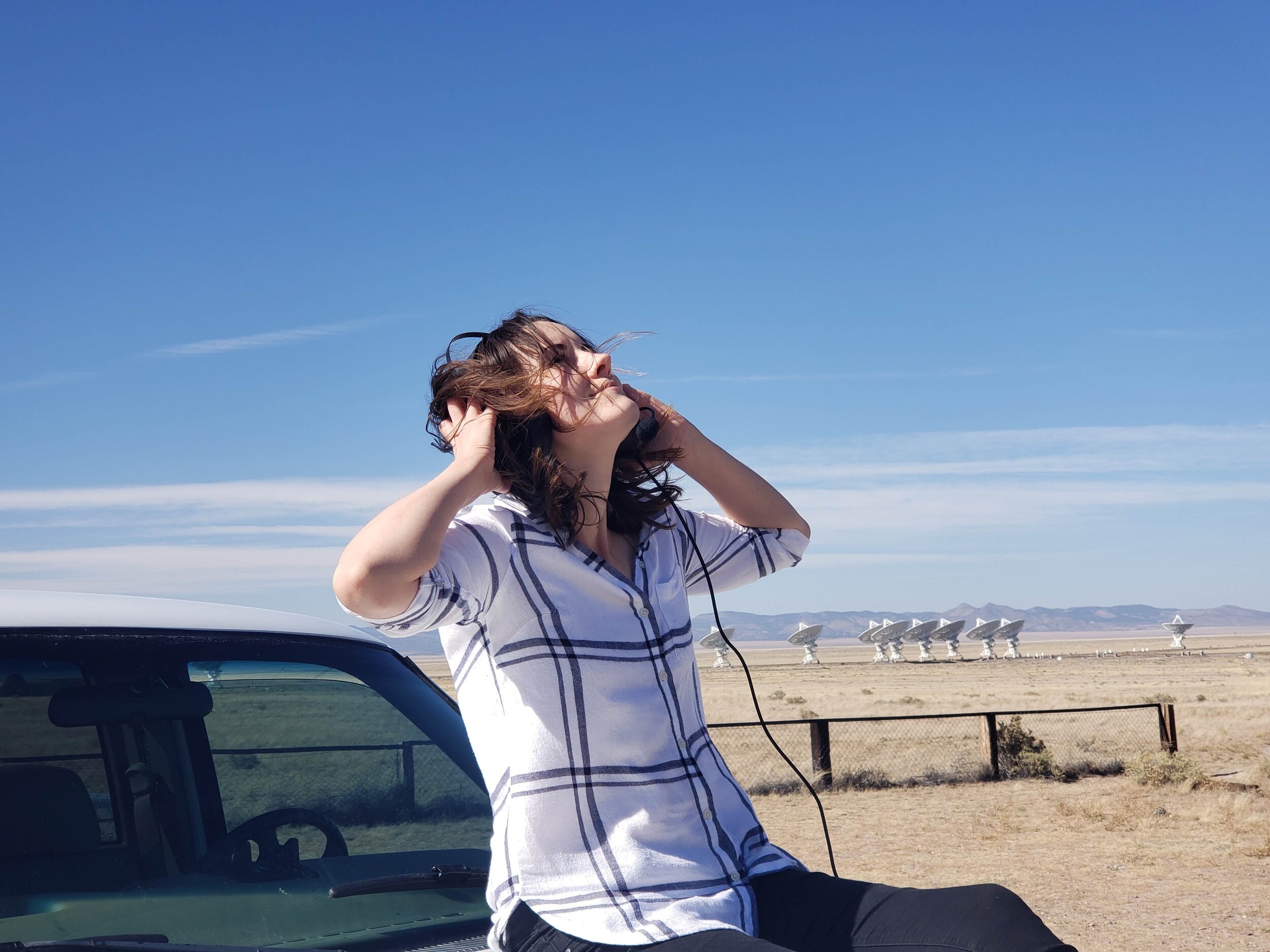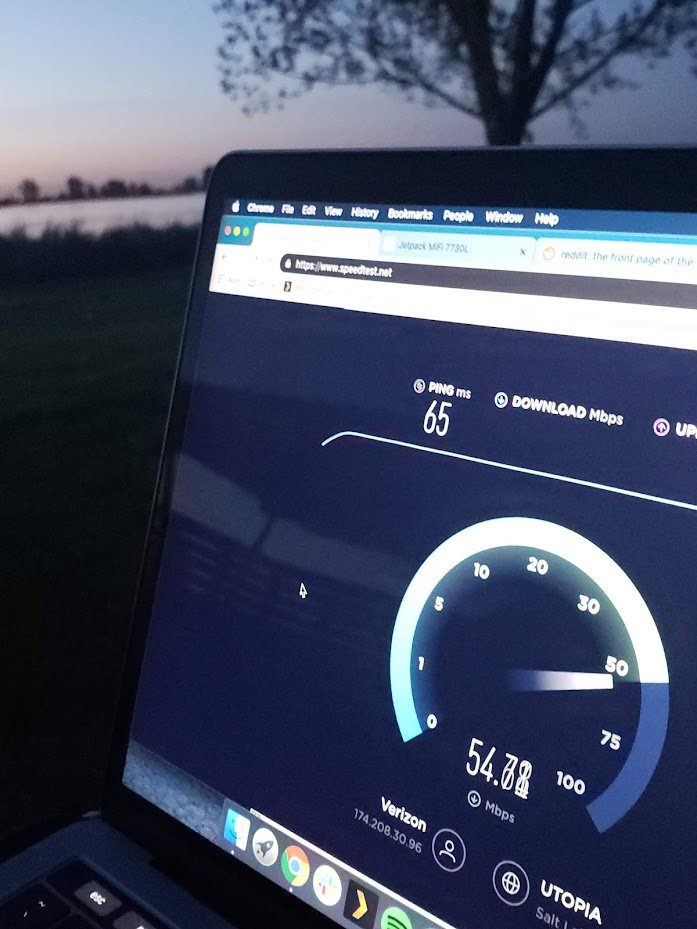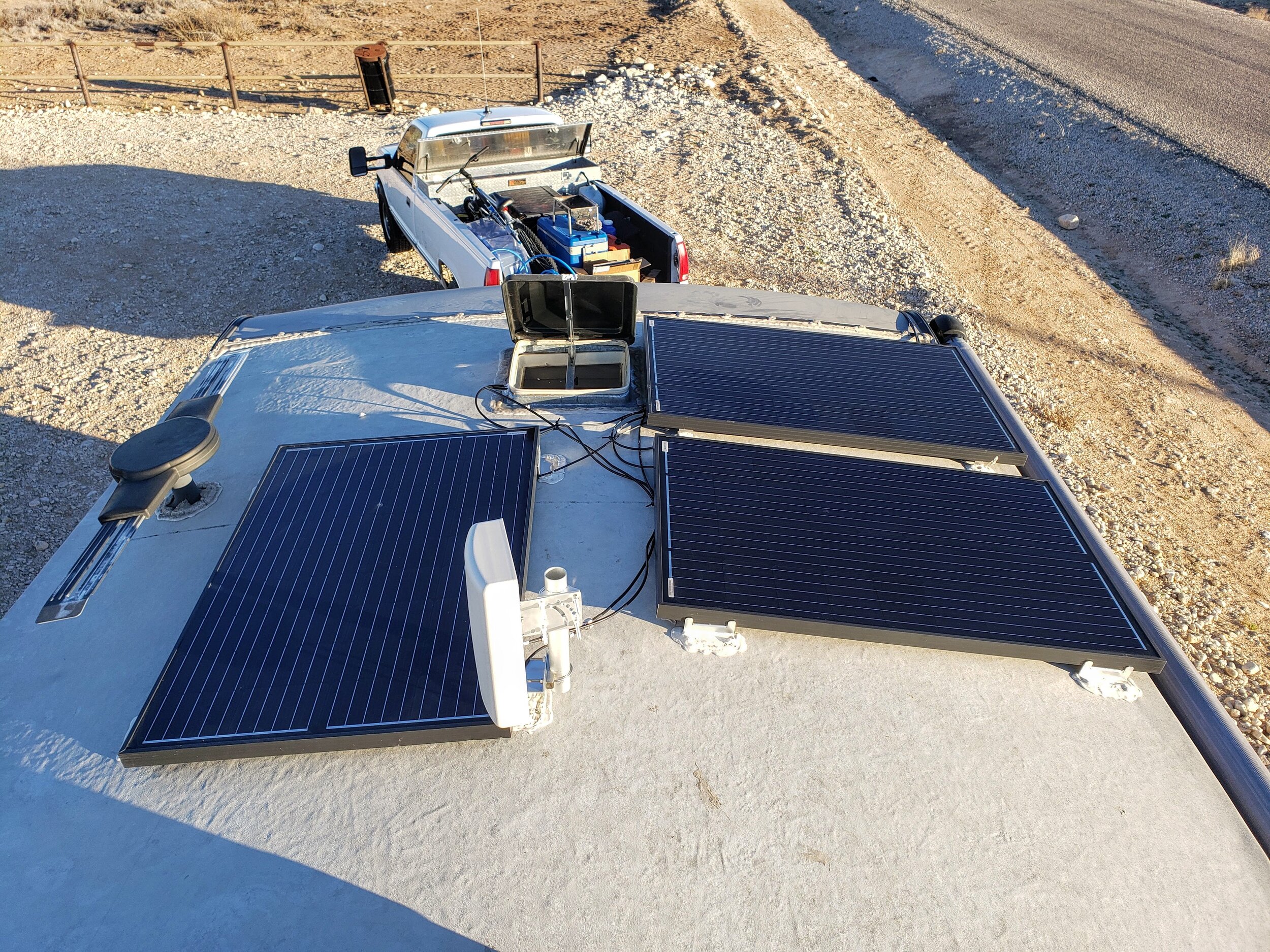
Working Remotely
How we work and play remotely while boondocking.
Data Plans
We are lucky enough to both have full time jobs that are purely remote, but staying connected is an entire art form/science/living expense that we’ve fine tuned every year we’ve been on the road. The crux, is you need at least 1 truly unlimited data plan to rely on, which can be hard to come by.
Our main data plans are covered in detail below.
Hardware
Once you have your data plans, we carry three ourselves, you need to get the best signal possible to cut down on latency and maintain a solid connection for Zoom, screen sharing, etc.
We use a Pepwave Max BR1 Pro 5g in synergy device mode, connected to a Pepwave Balance20x in synergy controller mode. We improve our 5g and 4g signals with a roof mounted Pepwave Mobility 42-G MIMO Antenna.
Backups
Starbucks is a solid backup if you just can’t find a signal. Our primary workflow for boondocking (details here) is to use campendium.com to check on recent cell reviews of any campsites before we head there ourselves. OpenSignal’s phone app is also a great way to look at real speed tests from mobile users in a particular area.
These two pre-checks typically work out but due to the nature of LTE, a crowded tower can be worse than dial up despite having full bars of reception. Know where you can go for wifi in a pinch!
How we stay connected
Our Current Setup
We have three data plans:
Starlink RV, $150/month (currently paused)
Verizon Grandfathered Prepaid Unlimited Plan $65.00/month
T-Mobile P800 $150/month
Hardware:
Pepwave Balance 20x
Peplink Mobility 42g 7 in 1 Antenna
Starlink Dishy V2 with custom 12v POE Injector
Netgear MR5200 as portable backup
Buy from reputable data resellers
We personally recommend getting a consultation and purchasing your LTE cell plans + equipment from mobilemusthave.com, a site run by full time RVers with great customer service and fast shipping.
We have purchased several cell plans, 2 Poynting Mimo Antennas, Pepwave BR1 Mini and Pepwave Balance20x from them without any trouble.
I commonly ask for tech support and receive answers within a day.
A cellular modem like a Pepwave is better than a hotspot or phone for this endeavor
If there are 2 key features that we rely on daily to make 4g/5g the best it can be its band locking (manually preferring bands on towers nearby) and a 4x4 MIMO Antenna setup for the best data throughput possible.
A hotspot simply can’t compete with these features, even our beloved little Netgear MR5200 which we use for 5g connectivity from time to time has a 2x2 MIMO limitation and command line telnet requirement to limit bands (tedious.)
There is no perfect single solution to mobile internet, you must have backups
Assuming you’re not just looking to stream Youtube but have a job you must be online for like we do, no single provider can provide 100 percent uptime as you move around.
Over the air internet providers (4g/5g/Starlink) are anything but a sure thing, there are many factors that can reduce your speeds and ability to work without notice. You need to understand how 4g/5g works, how to test connectivity and most importantly have a backup for when one provider is performing poorly in a given area.
What do I mean? Cellular towers in a given area can be extremely over crowded, this means no matter your plan tier (prepaid, postpaid, etc) you will be given what bandwidth allowance they allow and it will shift constantly.
When I arrive at a boondocking location I begin by doing a speed test on both our data plans via Cloudflare. Speed is important but not nearly as critical as latency and jitter. I then begin testing individual carrier bands to see if those figures improve at all.
For example, band 2 on Verizon can be 2-3x faster than the default band 4 due to traffic volume. Locking myself to band 2 greatly improves my speed, latency and jitter. This process takes a lot of time so get a cup of coffee or a beer.
Even with the onset of Starlink, we find ourselves still relying on our cell plans daily given Starlink’s growing pains and currently congested US Market. Starlink is also very adverse to any obstructions blocking its view of the Northern Sky, meaning no forest camping for you.
For work critical traffic we bond our connections together via Speed Fusion Cloud
Speedfusion Cloud — this is a cloud bonding service from Pepwave/Peplink that allows us to route latency and jitter sensitive traffic over two or more connections at once, typically Verizon + T-Mobile. We can apply different bonding algorithms to improve our redundancy, from Forward Error Recovery to WAN Smoothing.
Speedfusion bonds our internet services together and using WAN smoothing, we are able to greatly reduce if not entirely eliminate Zoom/MS Team call drops and lag spikes for these kinds of calls. We are duplicating or triplicating our data usage for these tasks, but this is controlled with rule sets so you don’t overuse the service for non critical traffic.
Status view of an active Zoom call from my Macbook air being routed over 2 WAN connections simultaneously via Speed Fusion Cloud.
Think of this bonding like climbing a mountain with two ropes, if one breaks you’re still holding on via the second.
Connectivity Guide for New Nomads
We get a lot of questions about all the different ways to potentially stay connected out here. I’ve compiled what I hope is a helpful list, originally made for the reddit.com/r/rvliving community.
⚠️ Your experience will vary, day to day, tower by tower, city by city. This guide makes 0 guarantees that you will enjoy immediate nirvana in your remote connectivity setup but the author hopes it helps.
👉🏽 LTE requires you to enjoy tinkering.
🤔 So what do I technically need to get internet on the road?
Some sort of data plan, included with your phone or wholly separate.
A device that takes that data connection and provides WIFI or hardwired connection to your desired devices
There are so many considerations for just those 2 items, that I wrote this tome of a post to try to help.
LTE/Cellular
The most common method to get connected, which can be as simple as utilizing the existing hotspot allowance your carrier gives you, turning on hotspot mode on your phone and off you go. The limitations here though are probably already obvious to you, data caps for most modern plans as of this post are pretty slim. 50GB goes quickly, especially if you're sharing screen or video and might want to watch a netflix episode or two after work.
What is the "best" cellular data plan?
Firstly, I recommend you stay subscribed to the Mobile Internet Resource Center and their incredible work to support the nomad community. They maintain a list of "best" plans here.
Secondly, this question comes up A LOT on this sub, understandably, you have to hope there is an ideal plan/holy grail to just get connected and work from the road. Unfortunately that answer is not that simple, and typically you see folks like me recommend you combine higher end equipment (like a Pepwave cellular modem) with 2 or more data plans to accomplish a "best possible" setup that is able to overcome issues on one provider without asking you to move from your chosen campsite.
At the time of this post, the cheapest way to obtain unlimited data is, in my opinion, via Visible a Verizon MVNO that can be as cheap as $25 dollars a month but comes with limitations: you can only have 1 device connected to your phone via hotspot and that device is speed limited to 5mbps. This is typically enough to conduct most work activities, but far from ideal for those of you who need to do larger file transfers for work or need more than 1 device to be supported, or like me have more than on person with a remote job in your RV. I personally run my phone on Visible but it is not how I work day to day, but it makes for a great mobile hotspot when I'm away from our RV.
What about third party data plans?
If in your Googling for mobile internet options you came across names like Calyx or Nomad Internet, or some crazy thing like RV Super Internet Provider 3000, you have stumbled across one of the more confusing but potentially helpful gray market areas of mobile connectivity: third party reseller/lease plans.
Calyx and Mobile Must Have are not some new cell networks you just completely missed on recognizing, they are third party vendors who have obtained some sort of data arrangement with Verizon, AT&T, Sprint (RIP), or T-Mobile. In some cases, larger enterprise businesses sublet their spare data plans to these resellers to turn a profit on otherwise unused sim cards.
There are also less recognizable names and even ebay sellers touting unlimited data plans, these are buy at your own risk, but still a viable option given the right terms/conditions. I've personally run 2 ebay based data plans without any trouble.
Like all things you pay for, I would encourage you to find fellow users and read reviews. Learn more about these plans and their availability from the folks at MIRC.
What is the best hotspot or mobile router to use with a data plan?
Ok gear heads, strap in. So once you've graduated from the idea of just abusing your phone to "make wifi" you'll find a lot more flexibility and options in a dedicated device, be it a hotspot or a more robust cellular modem.
Based on your data plan, you may be provided with or be held at gunpoint to purchase a required matching hotspot device, if so, well that's what you get. This is true for the plans from Calyx and FMCA.
We personally started out with a now quite ancient Verizon 7730L, which to its credit was pretty crap at making for reliable wifi (access point) but had great battery life and did its job just fine. It also was one of the last hotspots with external antenna ports. We have since graduated to the Pepwave line of cellular modems/routers for several key improvements that make, in my opinion, LTE connectivity more reliable.
Current cellular modems/routers
Optimizing data plan performance
Why the preference to a cellular modem/router like a Pepwave?
12v native power, band locking, frequency support (multi carrier), hot failover to a second sim plan, forward error recovery and typically more robust networking options.
If there was one feature that makes my day to day on the road with LTE work, it is band locking. Simply put, every tower from every carrier has a set of bands on it. Your hotspot will take what it is given and basically do what it is told, not able to deviate from the bands the tower wants it to use. Pepwave and similar devices from Mofi let you manually lock out and prefer certain bands.
What this can accomplish is a 4-5x improvement in the speeds you would get from a hotspot as you can lean on underused bands in that area (less congested ones.) Without band locking there are several favorite boondocking spots I can think of that would be unusable for me for work. A cellular modem like a Pepwave will also let you set everything to auto and just "work" but in the tinkering we find the ultimate reward, the best speed with the least latency and jitter.
So I want a booster really bad, I think. Why? (Antennas matter)
Antennas are super important in getting the best possible performance from any hotspot or cellular modem, but if your device has a built in antenna system they are not required. I personally would not run without a roof mounted antenna.
The most common question on here, after, "best internet pls thx?" is "what booster do you run?"
For me, none, I prefer a passive MIMO antenna, currently running this Peplink 42G.
Without providing a ton of bias, I would recommend you review the MIMO Antenna vs SISO Booster debate over here, with yes, you guessed it, the amazing team at MIRC.
It is very important to remember, and don't just take my word for it, bars of service are meaningless. They do not equate to speed. Having a great antenna is VERY important, but its just one part of the equation.
There are A LOT of antenna options and for that I'd recommend taking a peak at some reviews here. Ensure your hotspot or cellular modem is compatible with the antenna you want or get some help to ensure it is.
Biased opinion ahead -
Boosters unfortunately reinforce a poor standard by which we tend to visualize and see LTE internet, which is via the bar graph on our phones. We see signal bars as an indicator of quality, of robustness and we logically think the more we see, the faster we get. Unfortunately that is not true, while signal strength is important, you can have "full bars" and be operating at dial up speed or worse. A booster is incredible at its core job, of making some sort of cellular signal stronger, and if you were just making voice calls from the middle of nowhere it would be king. However, I have to make my upload and download the best it can be and for that I rely on MIMO.
A very detailed video on the topic from MIRC -- watch this and decide for yourself :)
I still want a booster!! Ok fine, reviews on those are here :)
What about Starlink? (read our ongoing review here)
Starlink and other low earth orbit systems in development could be the future of mobile connectivity, but the future is paved with betas and you should know going in, only time will tell if all the promises of Starlink pan out.
As a Starlink user myself I have to say that its our flagship connection, but I am by no means cancelling my LTE, as Starlink is amazing but still very much in beta. The folks over at MIRC said it well, in their latest Starlink video, cellular AND starlink are an incredible package, not starlink OR cellular.
You can read my review of my first few weeks with Starlink in our RV in the section below.
To answer some common questions and misconceptions around this tech:
Yes, you can move service addresses with Starlink. You are able to, at will, change your address in the self service portal. I have done so several times. However, there is now a roaming flag found in the debug data for most current starlink users, allowing you to simply move around without registering a new address. Read more here.
There is no RV, in motion antenna. TRUE. But that didn't stop u/tuckstruck from mounting theres in a tire carrier on their overland vehicle roof. I highly recommend you follow this amazing couple's journey and their real life data pushing the limits of starlink equipment right now
It can take years on a waitlist to get your dish. True. r/starlink is a great resource for given wait times by region and just to learn more. EDIT: an availability map is finally officially on the Starlink Website.
Its power hungry compared to LTE. Yes, Dishy Gen 2 is reported to need around 50 watts minimum and there is no over the counter 12v adapter available. In comparison, my Pepwave modem setup consumes 12 watts direct DC wired. So if you boondock like us, its means running an inverter to keep the dish on, for now. If you have the bench skills, u/tuckstruck built their own dc to dc setup for dishy.
Where to buy some of this equipment you speak of?
The Mobile Internet Resource Center, linked about 20x above does not directly sell any of the equipment they review or recommend. For that, I have personally used mobilemusthave.com but you can also find most of this equipment on Amazon, Ebay, etc.
What about internet from RV Parks and Resorts?
In the almost four years we've been on the road I can name about 3 parks who had usable internet. That being said if you want to try to get the most out of a current campground wifi (with full knowledge you can only improve your connection to the parks network, not make their actual infrastructure faster) I would recommend learning how to setup a Unifi Loco M2 point to point wireless bridge. A powerful tool for tapping into wireless networks at distance.
RVer David Bott has an older but still usable video on the subject.
In lieu of a Loco M2 you can also use Pepwave's Wifi as Wan feature with an internal or external wireless antenna to improve your range. More on your options here.
We are still evaluating Starlink, using it full time. Click below to read about our experience so far.
What about our laptops and peripherals?
Great question! Our rule here is to, whenever possible, run equipment that is native 12v DC powered so we don’t have to run our inverter which is a process that takes 12v and makes it 110v household current. That process is lossy, resulting in battery usage beyond the power requirement of the device.
We work on:
Two 2018 Macbook Pros charged via 12v USB C power cables
We watch TV on:
2 Roku TVs by TCL
We play video games on:
2021 Asus G14 Zephyrus that can run off 100w USB C charger or its native 160 watt AC power brick while on our inverter
2020 MSI GTX 27 Inch 1080p Monitor on a 15w DC power cable
Nintendo Switch which is USB C/12v Native






